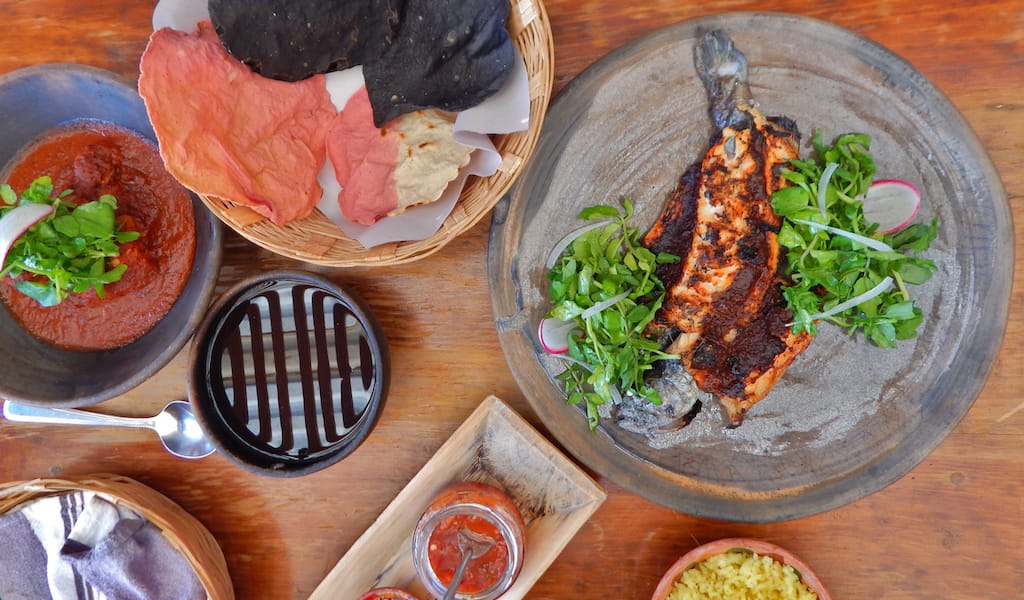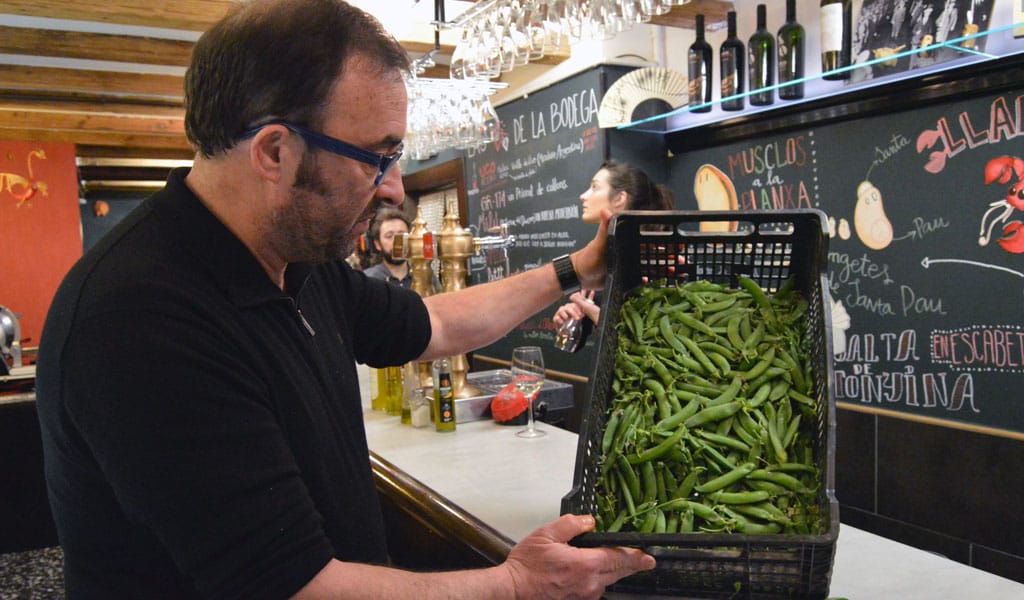It’s around noon on a Wednesday in Oaxaca, and we’re standing next to a huge, firewood-powered comal, that traditional Mexican clay griddle used to toast corn and cacao, blister tomatoes for salsa, melt stringy quesillo cheese inside the corn tortilla layers of a quesadilla, and so much more. Today, however, none of these more quotidian ingredients takes center stage on the blazing-hot, earthen red comal: Instead, Micaela Ruiz Martinez, 50, uses a small straw brush to sweep ants over the griddle’s surface, the insects dark, round rear ends resembling oversized black peppercorns.
As a slightly herbal, slightly fruity aroma begins to waft up from the comal, Martinez, chef and owner of the bright, homey restaurant Luz de Luna (“Moonlight”), comments, “Chicatanas have a really unique flavor. There’s really nothing else like it.”
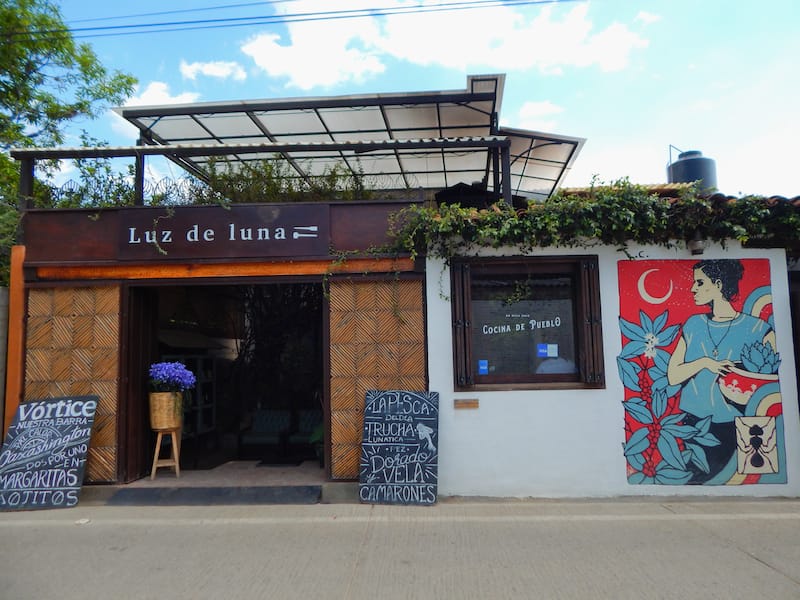
Martinez, who opened this popular spot with a sweeping view of the Oaxacan foothills 12 years ago, is referring to a species of large, winged leafcutter ants that are regarded as a delicacy here in the southwest Mexican state. Normally dwelling in underground colonies, chicatanas emerge in large numbers at the start of each rainy season, typically at the beginning of June, in order to seek their mates. And when they do – suddenly carpeting patios, backyards, and even paved streets – Oaxacans spring into action, grabbing a bowl, a colander, or even a plastic bag to scoop up the insects, toast them on the comal, and grind them into salsa.
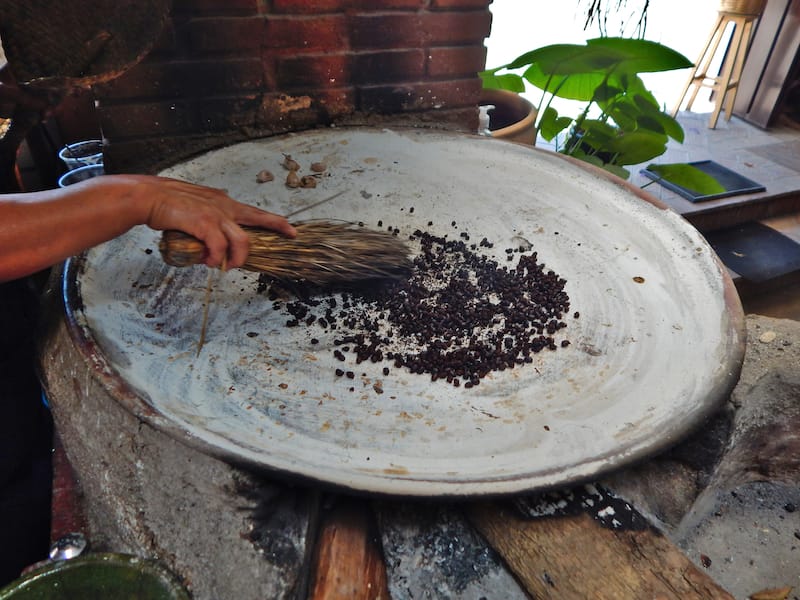
In recent years, the idea of eating bugs – previously considered a strange or distasteful one by much of modern society – has become far more mainstream. Touted as a climate-friendly source of protein that’s also rich in vitamins, minerals, and healthy fats, insects have, of late, shown up in a surprising number of prepared foods available in the United States and Europe, from the cricket flour-based crackers sold in Belgian grocery stores to the protein-packed French macarons made with ground mealworms.
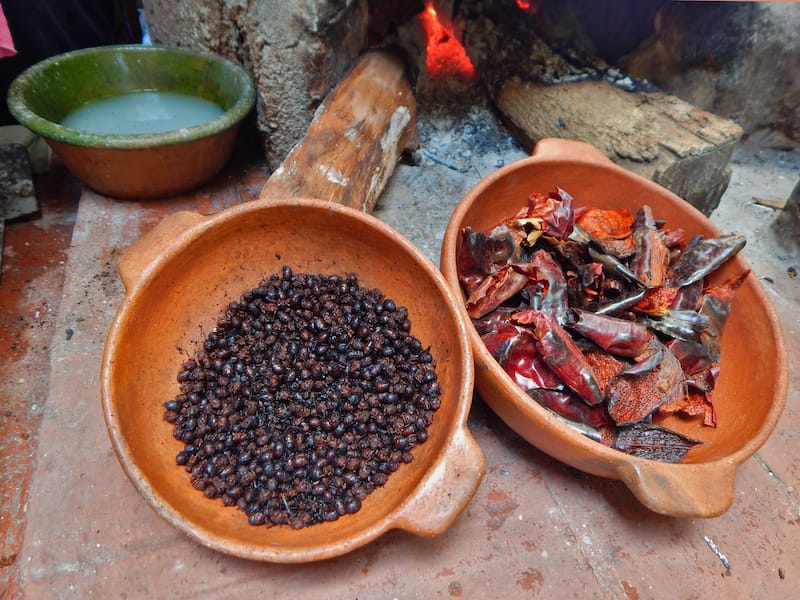
Typically, however, these snack foods strive to hide the insects’ true flavor and texture, making them unrecognizable by burying them with spices or sugar. Considering the products’ target market, the tactic makes sense: These urban populations are just not used to eating bugs. But all around the world, insects have long been a valued and traditional part of rural diets, and they’re typically not disguised very much. In Ghana, according to National Geographic, folks eat fried winged termites; in Bali, dragonflies are enjoyed boiled in aromatic coconut milk; and in aboriginal Australia, lightly cooked witchetty grubs, a type of moth larvae, are a seasonal delicacy.
In Oaxaca, as in other parts of Mexico, insects are a vital part of the diet. Far from being relegated to some distant, more agrarian past, species such as stink bugs, caterpillars, and grasshoppers are frequently included in everyday dishes ranging from giant, crispy, quesillo-stuffed tlayudas to the hot, creamy corn kernel street dish known as esquites to simply enjoyed toasted or fried as a botana, or snack, alongside a cold beer.
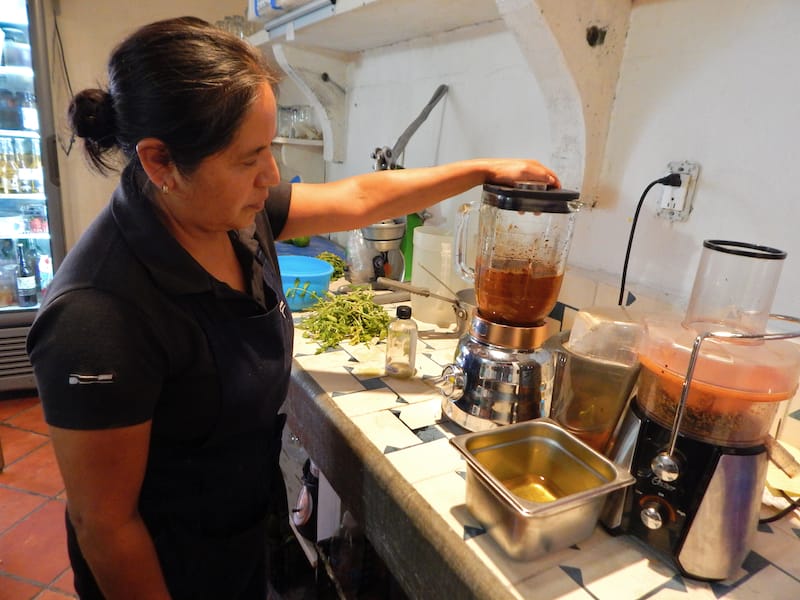
Among the many species of insects eaten by Oaxacans, chicatanas hold a special place in Martinez’s heart, she tells us as we move from the comal to the kitchen. “I’ve been eating chicatanas since I was a little girl,” she says, recalling the many rainy seasons in which she’d collect the ants alongside her mother and her siblings. Part of what makes them so special, Martinez explains, is their brief window of seasonality: not only do they emerge just in the rainy season, but at the very beginning of the rainy season, their availability of only a few days’ time enhancing their appeal. The chef likens the ants to the Oaxacan mountains’ famous wild mushrooms, whose numbers also explode during the rainy season, and whose arrival is, likewise, hotly anticipated each year.
This year in Oaxaca, the rainy season got off to a very stop-and-start kind of beginning, finally settling in in earnest in early July. But throughout June, when sporadic heavy rains brought some chicatanas above ground, families living nearby Luz de Luna showed up with small bags of the ants they had collected to sell to Martinez. “Everyone around here knows that I buy them” – the ants net between 300 and 1000 Mexican pesos per kilo, or between $18 and $59 USD – “and we pool the small quantities to add up to an amount we can use.” In fact, after years of employing this strategy, Martinez now freezes any extra ants—making salsa de chicatana a year-round possibility at Luz de Luna’s tables.
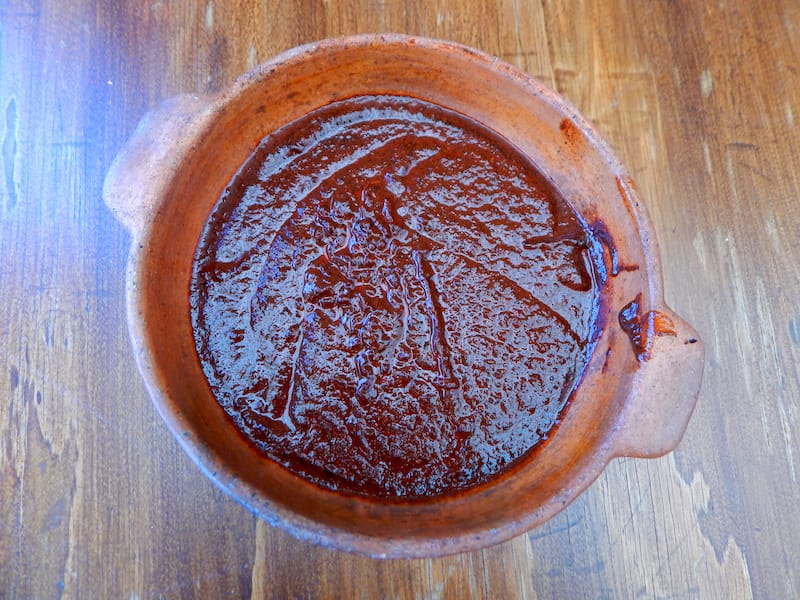
While the ants – sometimes drowned to dispatch them before being toasted on the comal, sometimes added directly to griddle while still alive – can be worked into a number of dishes, such as sprinkled onto the thick, open-faced breakfast tortillas known as memelas or ground into a complex mole sauce, the most common way to enjoy chicatanas is in a mildly spicy salsa de chicatana – one of Luz de Luna’s specialty condiments. The restaurant’s motto demonstrates its commitment to preserving Oaxaca’s historical insect gastronomy: “Entre el calor del comal, insectos, tejate, y mezcal,” it reads. “Between the heat of the comal, insects, tejate [a prehispanic beverage made from corn and cacao], and mezcal.”
Having toasted the ants, removed their wings, and kept only their large, round rear ends – “it’s the tastiest part of the ant,” she explains – Martinez tips them into a blender alongside only two other ingredients: dried guajillo chiles and plenty of garlic, both of which she also toasted on the comal. Blended with a little salt and just enough water to create a thick, glossy sauce, the salsa emerges from the appliance brick-red and highly fragrant. “You can add all kinds of ingredients to this salsa,” the chef tells us, “but I like to keep it simple, allowing the flavor of the chicatanas to shine through.”
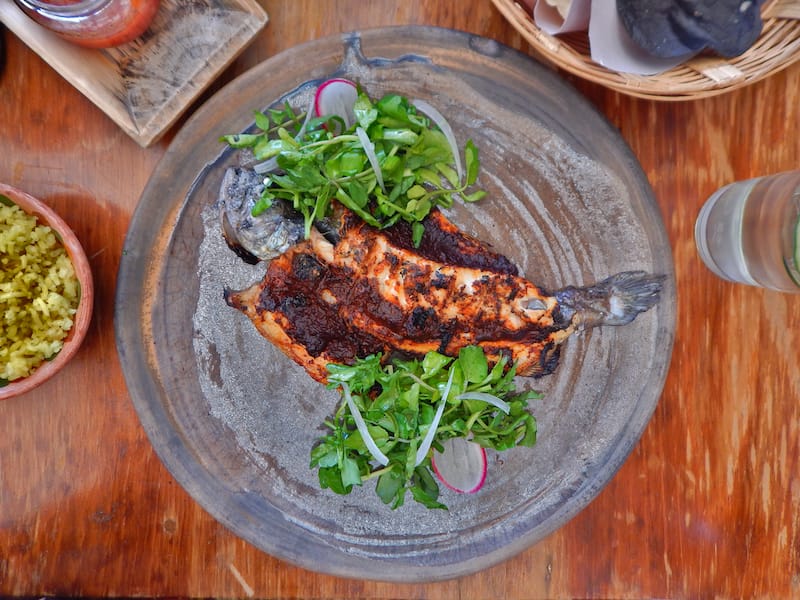
Luz de Luna serves its salsa de chicatana spread over a butterflied griddled trout sourced from the small-scale, freshwater farms common in the nearby communities in the Sierra Norte. The mild, flaky fish is perfectly complemented by the densely flavorful sauce, but Martinez explains that you can pair the salsa with almost anything: “Fish, shrimp, on a tostada, with meat, with cheese.” To underscore her point, the chef hands us a warm tortilla fresh off the comal, encouraging us to spread it with the salsa and nothing more.
So what, exactly, do chicatanas taste like? Martinez furrows her brow, thinking about the question. “Well…They don’t taste like any other ant!” Indeed, the insect’s flavor is difficult to describe, its fattiness recalling lard and tallow, and its origins in the soil bringing a distinct – and not at all unpleasant – earthiness to the palate, as well.
What Martinez can definitely say is that chicatanas represent tradition – both at Luz de Luna, and in Oaxaca as a whole. “Everybody knows salsa de chicatana. Everybody. And we’ll always have it on the menu.”
Lauren RothmanLauren Rothman
Published on August 02, 2023
Related stories
August 27, 2021
IstanbulIn these days of viral Instagram videos and WhatsApp chainmail, Turkish ice cream has become synonymous with fez-clad pranksters swooping and slinging a mound of sticky Kahramanmaraş dondurma (ice cream) out of the hands of questionably amused tourists. But Turkey’s dondurma tradition goes far beyond these attention-seeking tricks. Beloved institutions offering more than simple (though…
February 7, 2014
BarcelonaMorro Fi and Mitja Vida are two relatively new entrants to Barcelona’s vermuteo (“vermouthing”) culture, whose history stretches back to the turn of the last century. These two bars are the product of nostalgia for a bygone era fused with the social network- and urban design-driven present. The vermouth tradition in Barcelona was started in…
April 21, 2017
BarcelonaBarcelona’s urban sprawl makes it easy to forget that the city is adjacent to two fertile regions to the north and south, El Maresme and El Baix Llobregat, which provide numerous hyperlocal culinary treasures throughout the year. In spring as in other seasons, these treasures appear at markets and restaurants, their origins proudly displayed, sometimes…







































